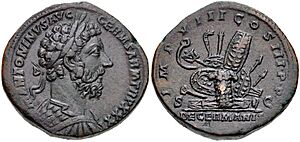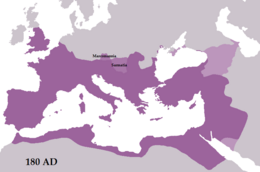Antonine Plague facts for kids
Quick facts for kids 
|
|
| Disease | probably smallpox |
|---|---|
| Date | 165-180 |
|
Deaths
|
5–10 million (estimated) |
The Antonine Plague was a long and very serious sickness that affected the Roman Empire from about 165 to 180 AD. It is also known as the Plague of Galen, named after Galen, a famous Greek doctor who wrote about it. This sickness was probably brought and spread by Roman soldiers. They were returning from a war in the Near East.
Most experts think the plague was smallpox. Some have also suggested measles. In 169 AD, the plague might have caused the death of the Roman emperor Lucius Verus. He ruled alongside Marcus Aurelius. These two emperors were adopted by the previous emperor, Antoninus Pius. Because of this, their family name, Antoninus, is linked to the plague.
Old records say the plague likely started during the Roman attack on the city of Seleucia in Mesopotamia. This happened in the winter of 165–166 AD. It was during a war led by Lucius Verus against the Parthian Empire. The sickness then spread to other parts of the empire, including Gaul and along the Rhine River. One historian, Eutropius, said that many people in the empire died from it.
According to another Roman historian, Cassius Dio, the disease came back nine years later in 189 AD. It caused up to 2,000 deaths a day in the city of Rome. This was about 25% of the people who got sick. It's estimated that 5 to 10 million people died in total. This was about 10% of the empire's population. The disease was especially deadly in cities and among the Roman army.
The Antonine Plague happened during the last years of the Pax Romana. This was a time of great peace and power for the Roman Empire. Historians have different ideas about how much the plague affected the empire after this time. Similar plagues also happened in the Han Empire in China around the same time. These plagues caused big problems there.
Contents
What Was the Antonine Plague?
The Antonine Plague was the first known pandemic (a sickness that spreads worldwide) in the Roman Empire. It spread throughout the Roman Empire and possibly even to China. Millions of people got sick. This pandemic happened during what many call the "golden age" of Rome. This was when co-emperor Marcus Aurelius was ruling.
At that time, the Roman Empire had about 75 million people. This was about one-fourth of all the people alive then. Historians generally agree that the Roman Empire's population was at its highest when the Antonine Plague appeared. After that, the population started to decrease.
Roman Life and Health
Even though the Roman Empire was rich, conditions were good for a pandemic to spread. Many people were not very healthy. About 20% of the population lived in cities. Rome, for example, had about one million people. Cities were often "demographic sinks." This means more people died than were born there. So, new people had to keep moving in to keep the city populations stable.
More than half of children died before becoming adults. The average person only lived into their mid-twenties. Crowded cities and poor sanitation made diseases more dangerous. The Roman Empire had many roads and sea routes. This made it easy for diseases to travel quickly from one area to another. Sicknesses were common in the empire. Nine epidemics were recorded between 43 BC and 148 AD. Even rich people were not safe. Only two of Emperor Marcus Aurelius's fourteen children lived to be adults.
One way to tell about people's health is their average height. Studies of thousands of skeletons show that Romans were shorter than people who lived in Italy before Rome. They were also shorter than people who lived after the Roman Empire ended. Some historians believe that while society was developing, it sometimes led to health problems.
How the Sickness Spread
Romans traditionally believed the Antonine Plague started because the Roman army broke into a temple in Seleucia. This happened during the war against the Parthians led by Lucius Verus. The soldiers then supposedly carried the sickness back to the Roman Empire in early 166 AD.
However, the first recorded case of the plague was in Smyrna (in Roman Anatolia) in 165 AD. A speaker named Aelius Aristides almost died from the disease there. From the east, the plague moved west. It reached Rome in 166 AD and almost every part of the empire by 172 AD. Co-emperor Lucius Verus died from the plague in 169 AD. The sickness also badly affected the Roman army.
The plague lasted until about 180 AD. Another outbreak, possibly related, hit Rome in 189 AD. During this time, two thousand people in the city often died in a single day. It's not known if this new outbreak affected the empire outside of Rome.
Understanding the Disease

In 166 AD, during the sickness, the Greek doctor and writer Galen traveled from Rome to his home in Asia Minor. He returned to Rome in 168 AD when the two emperors, Marcus Aurelius and Lucius Verus, called for him. He was there when the sickness broke out among soldiers in Aquileia in the winter of 168/69 AD.
Galen wrote down what he saw and described the sickness in his book Methodus Medendi ("Method of Treatment"). He also mentioned it in his many other writings. He called the plague "great" and said it lasted a long time. He described symptoms like fever, diarrhea, and a sore throat. He also noted a skin rash that sometimes had pus and appeared on the ninth day of the illness.
The information Galen gave doesn't perfectly identify the disease. But most experts think it was smallpox. Historian William Hardy McNeill believed the Antonine Plague and a later one (the Plague of Cyprian) were two different diseases. One was smallpox and the other was measles. The severe impact on Europe might mean people had never been exposed to these diseases before. This would mean survivors gained immunity. Other historians think both outbreaks were smallpox.
How the Plague Affected Rome
Historians have different ideas about how much the Antonine Plague impacted Rome. Some believe it was the start of the Roman Empire's decline. Others think it was a smaller event, not much worse than other sicknesses that often hit parts of the empire.
Estimates of deaths from the plague range from 2% to 33% of the Roman Empire's population. This means between 1.5 and 25 million people died. Most estimates suggest about 10% of the total population died (around 7.5 million people). Death rates were higher in cities and the army, up to 15%. If it was smallpox, about 25% of those infected would have died. This is because the survival rate for smallpox is often around 75%.
An early historian, Barthold Georg Niebuhr, said that the plague was a turning point for Rome. He believed the ancient world never fully recovered from it. More recently, historian Kyle Harper said the pandemic should be seen as a very important event in Rome's history. However, some other historians disagree. They say that while disease and climate had an impact, it wasn't as catastrophic as some suggest.
Some historians thought the plague made people more interested in Asclepius, the god of medicine. But old records don't show that his worship became more popular.
Impact on the Roman Army

Ancient writers said the plague was a disaster for the Roman army. They said the army was "reduced almost to extinction." This happened in 166 AD, at the start of the Marcomannic Wars. In these wars, Germanic tribes were attacking Roman lands south of the Danube River.
The plague's impact forced Emperor Marcus Aurelius to find and train new soldiers. He even recruited gladiators, slaves, and bandits. After a two-year delay, the emperor attacked the Germanic tribes in 169 AD. By 171 AD, the Roman army had pushed the invaders out of Roman territory. The war continued on and off until 180 AD, when Marcus Aurelius died. He might have died from the plague. The plague may also have affected the Germanic tribes.
Trade and China
A Chinese writer named Ge Hong was the first to accurately describe smallpox symptoms. Historian Rafe de Crespigny wondered if the plagues in the Eastern Han Empire in China were connected to the Antonine Plague. These Chinese plagues happened between 151 and 185 AD. De Crespigny suggested that the plagues led to the rise of a religious movement that caused the Yellow Turban Rebellion.
He also noted that it might just be a coincidence. But the Antonine Plague outbreak in 166 AD happened at the same time as a Roman embassy visited the Chinese court. This embassy claimed to represent "Andun" (which might have been Marcus Aurelius Antoninus or his predecessor).
Another historian, Raoul McLaughlin, thought that the Roman visitors to China in 166 AD could have started a new era of trade. But instead, it brought something much worse. McLaughlin guessed the plague started in Central Asia, from a small, isolated group of people. Then it spread to both the Chinese and Roman worlds. The plague caused "irreparable" damage to Roman sea trade in the Indian Ocean. This is shown by archaeological finds from Roman Egypt to India. Roman trade in Southeast Asia also decreased a lot.
However, Roman sea trade in the Indian Ocean, especially for silk and spices, did not stop completely. It continued until Egypt was lost to the Muslim Rashidun Caliphate.
See also
- List of epidemics


